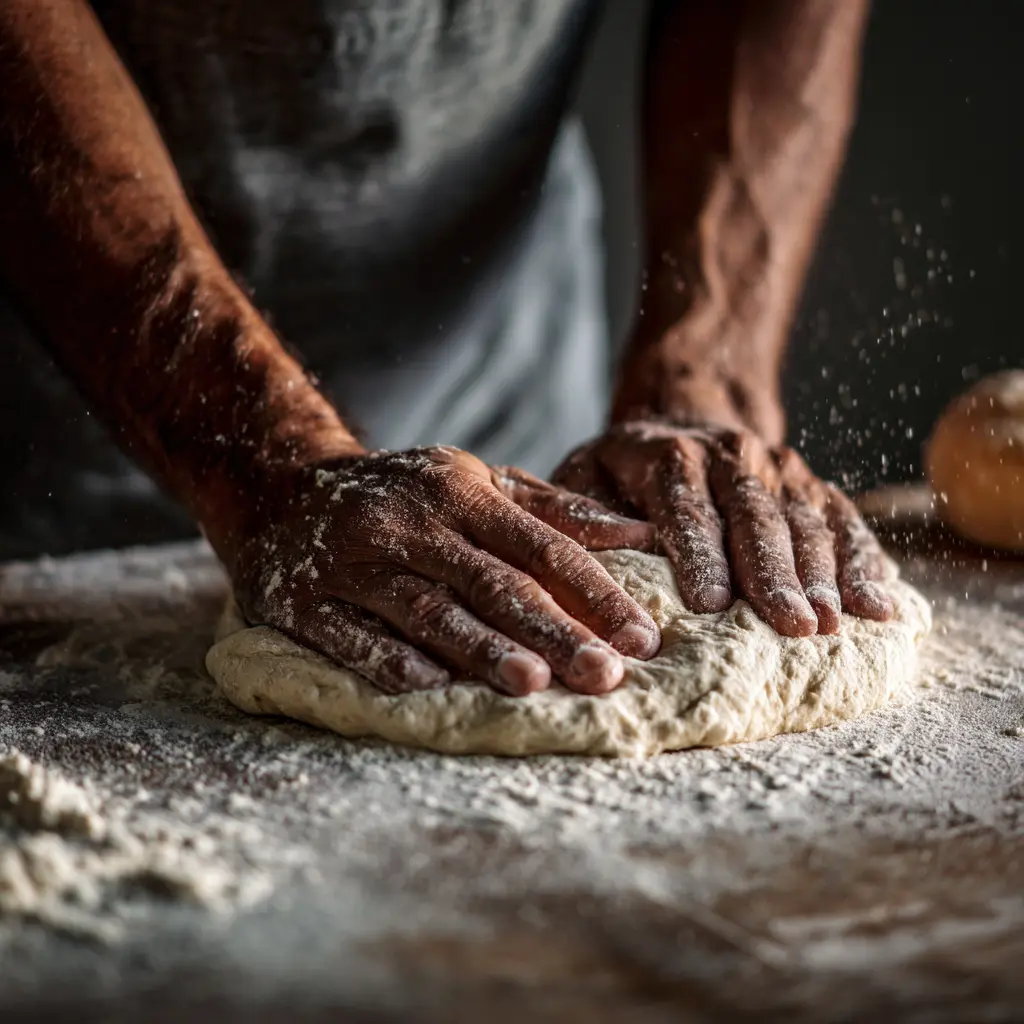Whole Wheat Sourdough Pizza Dough has been a labor of love here at DishRcp. It began one rainy afternoon when our founder, inspired by the rustic charm of European bakeries, decided to transform a lively jar of sourdough starter into something extraordinary. We wanted more than just a crust—we wanted a wholesome base that could carry both flavor and nutrition in every bite.
In our kitchen, we mixed golden whole wheat flour with our bubbly starter, drizzled in fragrant olive oil, and sweetened the process with a touch of honey. The air filled with the earthy aroma of freshly milled grain and the tangy scent of fermentation. Every step, from the first stir to the final bake, became a ritual—one that celebrated slow food, patience, and the joy of sharing a homemade pizza around the table.
The result? A pizza dough with a crisp, golden bottom, a chewy, tender crumb, and that signature sourdough complexity you can’t get from commercial yeast alone. Whether you bake it in a roaring wood-fired oven or your trusty home setup, this dough delivers every time. And because it’s made with 100% whole wheat flour, you’re getting more fiber, more flavor, and more satisfaction in every slice.

Don’t miss visit our pinterest
Table of Contents
Table of Contents
Why Choose Whole Wheat Sourdough Pizza Dough
The Nutritional Edge of Whole Wheat Flour
When you choose whole wheat flour for pizza dough, you’re making a decision that’s both flavorful and health-conscious. Unlike refined white flour, whole wheat flour retains the bran and germ, packing in fiber, vitamins, minerals, and healthy fats. This means every bite of Whole Wheat Sourdough Pizza Dough delivers sustained energy and better digestion support. Plus, the nuttier flavor profile pairs beautifully with the complex tang of sourdough.
From a health perspective, whole wheat flour helps you feel fuller longer, making your pizza indulgence a bit more balanced. And for those who appreciate a rustic, hearty crust, whole wheat offers that deep, satisfying bite that white flour can’t quite match.
Sourdough Fermentation: Flavor and Digestibility
Sourdough isn’t just a trend—it’s a centuries-old baking tradition that enhances flavor while improving digestibility. The natural fermentation process breaks down gluten and phytic acid, making nutrients more bioavailable and easier on your stomach. This means Whole Wheat Sourdough Pizza Dough isn’t just tastier; it can be gentler for some people with gluten sensitivities (though it’s not gluten-free).
The fermentation also develops those signature flavor notes—slightly tangy, aromatic, and complex—making every slice a gourmet experience. The longer you let your dough ferment, the richer this profile becomes.

Whole Wheat Sourdough Pizza Dough
- Total Time: 45 minutes
- Yield: 4 pizzas 1x
Description
Made entirely with 100% whole wheat flour, this sourdough pizza offers a rich, nutty flavor and a satisfying chewy bite. Naturally leavened and slow-fermented, it transforms the classic pizza into a wholesome, rustic creation that’s as hearty as it is delicious.
Equipment
- Digital Scales
- Mixing Bowl
- Pizza Trays
Ingredients
- 200 g Sourdough Starter
- 280 g Water (with extra 50g of water ready just in case)
- 20 g Honey
- 30 g Olive Oil
- 500 g Whole Wheat Flour
- 20 g Salt
Instructions
In a large mixing bowl, combine the sourdough starter, water, and honey (add yeast if using). Stir until the starter and honey are fully dissolved.
Add the olive oil, whole wheat flour, and salt. Gently mix with a dough whisk or knife until all ingredients come together. If the dough feels dry, gradually add extra water—this can vary depending on your starter, the flour, and the weather.
Cover the bowl with plastic wrap and let the dough rest for about 30 minutes to allow the flour to hydrate.
Knead the dough by hand or in a stand mixer until smooth and supple. Note that whole wheat dough will feel less elastic than white flour dough.
Cover and let the dough rise at room temperature until it has doubled in size.
Once risen, divide the dough into portions weighing between 200 g and 300 g each (250 g is ideal for most pizza ovens). Shape each portion into a ball.
Place the dough balls on the counter, cover with a bowl or dish towel, and let rest for 30 minutes to relax the gluten.
When ready to shape, press the dough gently from the center outward with your fingers, leaving a slightly thicker edge. If needed, lift and rotate the dough, letting gravity stretch it. Since this is 100% whole wheat dough, it will be less stretchy—use a rolling pin if preferred.
Transfer shaped dough rounds onto pizza peels dusted with flour or semolina. Add your favorite toppings.
Preheat the oven to 230°C (450°F) and ensure it’s fully heated. Bake pizzas for about 15 minutes, or until the crust is crisp and the toppings are cooked.
For wood-fired or gas pizza ovens, bake at 350°C–400°C (662°F–752°F) for about 2 minutes for best results.
Notes
For best results, use freshly milled whole wheat flour and bake on a pizza stone.
- Prep Time: 30 minutes
- Cook Time: 15 minutes
- Cuisine: Italian
Nutrition
- Serving Size: 203g
- Calories: 467kcal
- Sugar: 4g
- Fat: 8g
- Saturated Fat: 1g
- Unsaturated Fat: 5g
- Trans Fat: 1g
- Carbohydrates: 84g
- Protein: 14g

Essential Ingredients for the Perfect Dough
Choosing the Right Whole Wheat Flour for Pizza Dough
The success of Whole Wheat Sourdough Pizza Dough starts with the flour. Not all whole wheat flours are created equal—some are finely milled for a lighter texture, while others are coarser and add more chew. For pizza dough, aim for freshly milled or high-quality whole wheat flour that balances flavor with structure. The protein content is especially important, as it influences gluten development, which in turn affects how your dough rises and holds its shape.
If you want a slightly lighter crust without losing whole wheat’s benefits, you can blend in 10–20% bread flour. This can give the dough more elasticity while preserving the nutty, hearty character.
Sourdough Starter: Active vs. Discard for Pizza
The soul of your dough is the sourdough starter. Using an active starter will give you maximum lift and a more pronounced tang, while a discard-based dough creates a softer, milder crust. In our recipe, the starter works hand in hand with the whole wheat flour to produce a chewy, flavorful base that’s easy to digest.
The key is to ensure your starter is well-fed and bubbly before mixing. This ensures proper fermentation and a beautiful rise. And remember, hydration matters—whole wheat flour absorbs more water than white flour, so be ready to adjust your recipe with an extra splash if needed.
Step-by-Step Recipe Instructions
Mixing and Hydrating the Dough
To start your Whole Wheat Sourdough Pizza Dough, measure out 200 g of active sourdough starter, 280 g of water, and 20 g of honey. Stir until the starter and honey dissolve completely. This step ensures the natural yeast in your sourdough starter wakes up and begins feeding. Next, add 30 g of olive oil, 500 g of whole wheat flour, and 20 g of salt. Mix gently with a dough whisk or knife until all ingredients are incorporated. If your Whole Wheat Sourdough Pizza Dough feels too dry, add a little extra water—up to 50 g—because whole wheat flour tends to absorb more moisture than white flour.
Once mixed, cover the bowl with plastic wrap and let it rest for about 30 minutes. This resting period allows the flour to hydrate fully, which helps your Whole Wheat Sourdough Pizza Dough become softer and easier to knead.
Kneading Techniques for Whole Wheat Sourdough
After resting, you can knead the dough either by hand or with a stand mixer. Whole wheat dough has less elasticity than white dough, so kneading is important for building gluten strength. Knead your Whole Wheat Sourdough Pizza Dough until it’s smooth and supple—about 8–10 minutes by hand or 5–6 minutes in a mixer. If using a mixer, keep it on a low speed to avoid overheating the dough.
Once kneaded, place the dough back in the bowl, cover it, and let it rise at room temperature until it doubles in size. This can take 4–6 hours, depending on the strength of your starter and the temperature of your kitchen.
Fermentation and Proofing Tips
Understanding Bulk Fermentation Time
The magic of Whole Wheat Sourdough Pizza Dough happens during bulk fermentation. This is when the dough develops its airy structure, deep flavor, and tender chew. Because whole wheat flour contains more bran, it can slow down gluten development, so patience is key. Let your Whole Wheat Sourdough Pizza Dough rise in a warm, draft-free spot until it has doubled in size. Depending on your starter’s strength, this can take anywhere from 4 to 8 hours. If your kitchen is cooler, you can create a warm proofing environment by placing the dough in a turned-off oven with the light on or in the microwave with the door ajar.
How to Tell When the Dough Is Ready
A well-proofed Whole Wheat Sourdough Pizza Dough will feel airy and spring back slowly when gently pressed with a fingertip. If it collapses or deflates, it’s likely over-proofed; if it feels dense and resists pressing, it needs more time. Whole wheat flour absorbs more water and creates a slightly denser crumb than white flour, so expect your Whole Wheat Sourdough Pizza Dough to be a touch less elastic. That’s normal—and it’s exactly what gives the crust its rustic character. For even better results, you can slow-proof the dough overnight in the refrigerator, which deepens flavor and makes handling easier.
Shaping and Stretching the Dough
Using Hands vs. Rolling Pin for Whole Wheat Dough
When shaping your Whole Wheat Sourdough Pizza Dough, you have two main options: hand-stretching or using a rolling pin. Hand-stretching helps preserve the air bubbles created during fermentation, giving your crust a lighter, more open texture. To do this, gently press the center of your Whole Wheat Sourdough Pizza Dough outward with your fingertips, leaving a slightly thicker edge for the crust. Then, pick it up and rotate it in your hands, letting gravity stretch it naturally.
If you prefer a more uniform thickness, a rolling pin works well—especially since whole wheat dough is slightly less elastic. Just remember, using a pin can press out some of the gas pockets, resulting in a denser base. Choose the method that best fits your desired texture for the Whole Wheat Sourdough Pizza Dough.
Getting the Perfect Pizza Round
Aim for a round that’s about 10 inches (25 cm) across if you’re baking in a pizza oven. For home ovens, you can go slightly larger, up to 12 inches. Start with dough balls between 200 g and 300 g each—250 g is our sweet spot. Rest the shaped Whole Wheat Sourdough Pizza Dough for about 30 minutes under a towel or bowl to relax the gluten before adding toppings. This step makes it easier to stretch without tearing.
Once shaped, place the dough on a pizza peel dusted with flour or semolina to prevent sticking. Now it’s ready to be topped and baked.

Baking the Pizza for Maximum Flavor
Home Oven Baking vs. Wood-Fired Ovens
The way you bake your Whole Wheat Sourdough Pizza Dough can make or break the final crust. In a home oven, preheat to 230°C (450°F) and let it heat fully before sliding in your pizza. A baking stone or steel will help replicate the intense bottom heat of a professional oven, giving your Whole Wheat Sourdough Pizza Dough that sought-after crisp bottom. Bake for about 15 minutes, or until the crust is golden and the toppings are perfectly cooked.
If you have access to a wood-fired or gas pizza oven, you’re in for a real treat. These ovens can reach 350°C–400°C (662°F–752°F), baking your Whole Wheat Sourdough Pizza Dough in just 2 minutes. The intense heat creates blistered edges, a chewy crumb, and a smoky flavor that pairs beautifully with whole wheat’s nutty undertones.
Temperature and Time Guidelines
For the best results, always bake your Whole Wheat Sourdough Pizza Dough on the highest safe heat your oven can handle. A hot oven is key to achieving a balance between a crispy exterior and a tender interior. In lower temperatures, the dough may dry out before it crisps, while overly high heat without proper monitoring can burn the bottom before the toppings cook through.
Keep an eye on the pizza after the halfway point, rotating it if needed for even cooking. And remember—your Whole Wheat Sourdough Pizza Dough is already packed with flavor from fermentation, so baking is all about locking in that taste and texture at its peak.
Flavor Variations and Toppings
Classic Margherita to Gourmet Creations
One of the joys of Whole Wheat Sourdough Pizza Dough is how versatile it is with toppings. For a classic approach, keep it simple with fresh mozzarella, ripe tomatoes, and basil. The nuttiness of the crust complements the sweetness of tomatoes and the creaminess of cheese beautifully.
For something gourmet, try roasted vegetables, caramelized onions, goat cheese, and a drizzle of balsamic glaze. The deep flavor of Whole Wheat Sourdough Pizza Dough enhances savory, sweet, and tangy toppings equally well. Even minimalist toppings like olive oil, garlic, and fresh herbs can shine on this richly flavored base.
Pairing Flavors with Whole Wheat Sourdough Crust
Because Whole Wheat Sourdough Pizza Dough has a hearty, earthy taste, it pairs especially well with bold ingredients. Smoked meats, aged cheeses, sun-dried tomatoes, or wild mushrooms all bring out its character.
If you’re going plant-based, roasted bell peppers, artichoke hearts, and arugula can balance the tangy chew of the crust. For spice lovers, hot honey or chili oil drizzled over the baked pizza adds a punchy contrast to the natural sweetness of whole wheat.
The truth is, Whole Wheat Sourdough Pizza Dough is so flavorful that it can stand on its own—you could brush it with olive oil, sprinkle with sea salt, and bake it plain as a flatbread appetizer.
Common Mistakes and How to Avoid Them
Overproofing or Underproofing the Dough
One of the biggest challenges when working with Whole Wheat Sourdough Pizza Dough is getting the proofing time right. Overproofing causes the dough to collapse and lose its airy structure, while underproofing results in a dense, heavy crust. Since whole wheat flour ferments a bit differently than white flour, it’s important to monitor the dough closely. A properly proofed Whole Wheat Sourdough Pizza Dough will double in size and spring back slowly when pressed with a fingertip.
Preventing a Dense, Heavy Crust
Whole wheat’s bran can cut through gluten strands, which sometimes leads to a dense base. To avoid this, ensure your Whole Wheat Sourdough Pizza Dough is adequately hydrated—don’t be afraid to add that extra splash of water if the dough feels stiff. Kneading thoroughly also helps develop enough gluten for a soft, chewy texture.
Another common mistake is overloading the pizza with toppings. While tempting, too many toppings can weigh down your Whole Wheat Sourdough Pizza Dough, making it soggy instead of crisp. Keep toppings balanced so the crust can bake evenly and stay light.
Conclusion
Making Whole Wheat Sourdough Pizza Dough at home is more than just preparing a crust—it’s creating a base that carries rich, rustic flavor and wholesome nutrition in every bite. From selecting quality whole wheat flour to nurturing a lively sourdough starter, every step adds depth to your pizza experience. The slow fermentation process rewards you with a crisp exterior, chewy interior, and that signature tang that sets sourdough apart.
Whether you bake it in a roaring wood-fired oven or your trusty home setup, this dough delivers results worth savoring. Pair it with fresh, seasonal toppings or go gourmet with bold, complex flavors—either way, your pizza will stand out. And once you master Whole Wheat Sourdough Pizza Dough, you’ll find countless ways to adapt it for flatbreads, calzones, and more.
FAQs About Whole Wheat Sourdough Pizza Dough
Does whole wheat flour work with sourdough?
Yes. Whole wheat flour works beautifully with sourdough because it provides more nutrients for the wild yeast and bacteria in your starter. The result is a richer flavor and slightly denser crumb that suits Whole Wheat Sourdough Pizza Dough perfectly. It may need a little extra water compared to white flour doughs, but the payoff is a crust with nutty depth and a satisfying chew.
Can I use whole wheat for pizza dough?
Absolutely. Whole wheat flour not only works for pizza dough, but it also gives your Whole Wheat Sourdough Pizza Dough a unique, rustic character that white flour can’t match. It’s more filling, more flavorful, and has a beautiful golden hue. While it may be less elastic, a well-fermented dough still stretches easily enough for perfect pizza bases.
Is sourdough pizza dough healthier?
Yes. Sourdough fermentation breaks down some of the gluten and phytic acid in flour, making nutrients more available and the dough easier to digest. When you combine this process with whole wheat flour, your Whole Wheat Sourdough Pizza Dough becomes a powerhouse of flavor, fiber, and nutrition. It’s still an indulgence, but one that comes with more health benefits than conventional white-flour, yeast-based pizza doughs.
